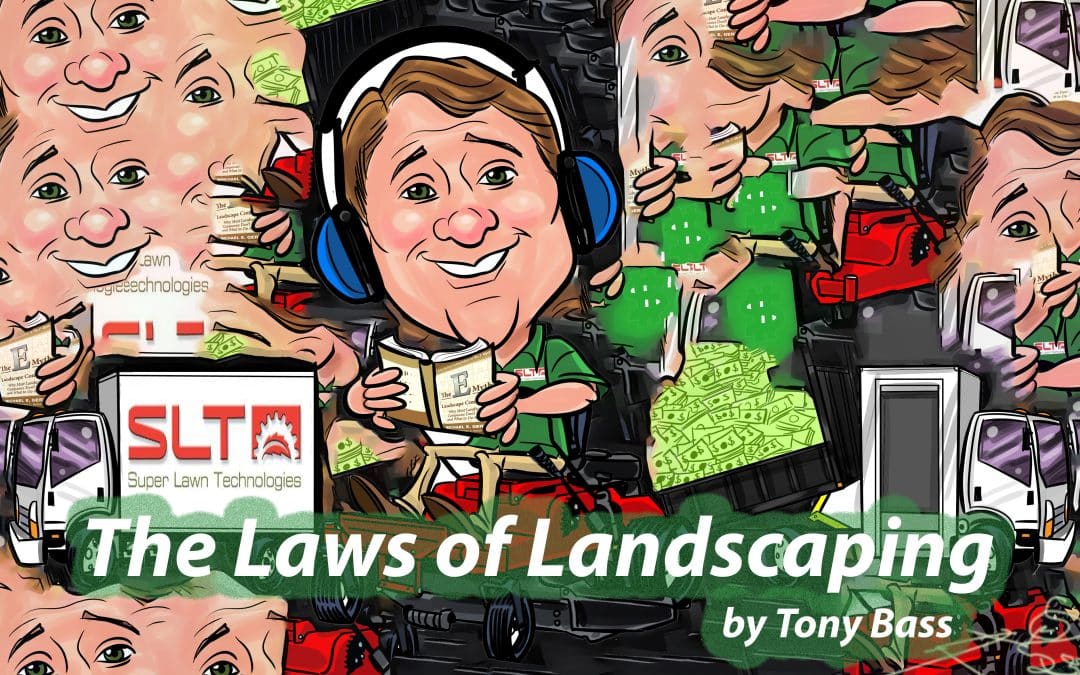Introduction
Once upon a time, in a quiet little town, there lived a landscape business owner named Mark. Mark was passionate about transforming yards into lush green gardens. He had a thriving business, a dedicated team, and a vision for the future.
But every few months, something seemed to pop up…unexpected…and these events were crippling to the business cash flow. For example, twice a year, he had to make an “extra payroll”. The employees got an extra check and Mark had to skip his paycheck.
Even though Mark worked hard. Even though he worked long hours, it seemed like these challenges would almost wipe out his bank account.
Mark started reading books on the subject of personal finance. He read the book titled The Total Money Makeover by Dave Ramsey. Mark learned he needed a new diet of beans and rice in order to become a business success. He was spending more money than he should be spending on food, dining out and drinking coffee.
He then read the book The Laws of Money, The Lessons of Life, by Suze Orman. He learned that in order to become a financial success, he better tell the truth about money. When he faced the truth, he learned that he didn’t have enough of it in his bank account!
It turns out that each “financial expert” recommends that you should have a 3 month to 6 month “emergency fund” as part of your financial goals. But, how in the world can you build up enough cash to operate for 3-6 months when you barely have enough to operate for one or two weeks?
Mark was interested in learning more about money. But most importantly, he wanted to learn more about the money coming in and out of his landscaping business. After all, it seemed like plenty of money was always coming in. But just as quickly, the money would go right back out.
Then he heard about this landscaping guy who would teach landscaping business owners about money. Most importantly, this landscaping guy would teach lawn and landscaping business owners how to build an exceptionally profitable landscaping company.
Mark thought to himself, “I gotta take a careful look at this.” Mark was so frustrated with being short on money, he thought it was worth a look and listen. So Mark decided to watch a webinar titled, “Lawn and Landscape Pricing Guide”.
During the webinar, Mark learned about the biggest pricing mistakes made by landscape business owners. It turns out, Mark had been making all of them!
Mark also learned an important lesson about how to identify his best, most profitable customers during the webinar. Now he knew how to find more customers just like those!
Surprisingly, he even learned what the pay rates for landscaping employees should be so he could attract and keep better employees. That would be huge as he continued to grow!
The landscaping guy on the webinar said the same thing over and over, “If you want to build an exceptionally profitable company you must follow the formula. The formula says you must: 1) Price Right, 2) Keep Promises and 3) Create Client relationships built on mutual trust and respect, not based on low prices”.
The guy on the webinar also said one more thing that really made him think. “Everything that happens in your lawn or landscape company is subservient to how you price your work. Until you Price Right, you will always struggle to build cash.”
Mark thought to himself, “Perhaps I need to listen to this landscaping guy a little more.”
Because what the landscaping guy said next was way different than what he had learned by reading the books written by Dave Ramsey and Suze Orman. The landscaping guy said, “Stick around this industry for a few decades and you’ll learn that no one goes out of business because of a lack of work. Landscaping businesses are destroyed because the leadership of the company takes on too much work, too fast, with prices that are too low and cost controls that are too loose and they destroy themselves.”
The landscaping guy said one more thing that Mark had never heard before. “Landscaping companies should set a goal to build a cash account equal to 12 months of company overhead. When you do this, you will never feel the pressure and frustration of being short of money again.”
Mark said, “What? Twelve months of overhead in the form of cash? Could this be true? That would mean I should have a big pile of money in my bank account. Could my business really build a fat emergency fund bank account?”
Mark knew that in the world of landscaping, Mother Nature could be unpredictable, the economy is unpredictable and the business could face unexpected challenges.
That’s when Mark realized the importance of having a fat emergency fund.
Chapter 1: Riding the Seasons
Mark’s landscape business was a rhythm of seasons. Spring brought a surge in clients eager for garden makeovers, while winter whispered tales of quietude. Mark started by raising his prices like the landscaping guy had recommended. In fact, after raising his prices 3 times in one month, he found he was still selling work! These price increases helped him build a modest three-month emergency fund, just enough to see him through the lean winter months. It served its purpose, but Mark dreamt of something more substantial.
Chapter 2: Nature’s Fury
One summer, a fierce storm swept through the town, wreaking havoc on Mark’s client’s gardens. Trees lay fallen, and once-lush lawns were reduced to muddy swamps. Mark’s phone rang off the hook with clients seeking emergency repairs. Since Mark had a great reputation, he was able to raise prices further and take on more work than ever. The storm had been a blessing for his company. His cash account grew even bigger as he followed a plan to collect Ethical Storm Profits. With his four-month emergency fund, he had the resources to mobilize his team, bring in equipment, and restore order. His clients were impressed with his swift response, and word of mouth spread like wildfire.
Chapter 3: The Beast of Downtime
Landscapers rely on their equipment like knights do their swords. One Monday morning, Mark’s team came in like every other Monday. But on this day, they found a huge hole had been cut into the side of their shop. Two trucks had been stolen, along with all the equipment loaded on those trucks. Mark had insurance. But he learned that his insurance was slow to pay up. And he had to face the fact he would only be paid the depreciated value for that equipment. Thankfully he had been serious about building that emergency fund! He quickly replaced the stolen equipment and was back in business in no time. His clients never noticed the hiccup, and Mark marveled at how that fat emergency fund had saved the day once again.
Chapter 4: The Art of Flexibility
With a healthy emergency fund, Mark could adapt and grow. He didn’t have to worry about making ends meet during slow periods. He used the fund to invest in training for his team and to launch a marketing campaign to attract more clients. His business expanded, and the emergency fund became a catalyst for his growth.
Chapter 5: Surviving the Storm
Then came the NEXT great economic downturn. Many businesses in the town closed their doors, but Mark’s landscape business weathered the storm. His twelve-month emergency fund allowed him to retain his loyal team and keep operations running. While others struggled to stay afloat, Mark’s business not only survived but thrived as he seized opportunities in the midst of adversity. Mark had the cash to purchase a retiring competitor. It seemed that growth opportunities would find Mark over and over again!
Chapter 6: Peace of Mind
Through it all, Mark discovered that his fat emergency fund offered something invaluable—peace of mind. He could face each day with confidence, knowing that his business was financially secure. It allowed him to make decisions based on long-term strategy rather than short-term survival.
Chapter 7: A Legacy of Responsibility
As Mark’s business flourished, he realized that he wasn’t just building a successful landscape business; he was setting an example. His responsible financial management inspired trust among his employees, clients, and partners. Mark’s legacy extended beyond beautiful gardens; it was one of fiscal discipline and resilience.
And so, dear landscape business owners, Mark’s story is a testament to the power of a fat emergency fund. It’s not just about preparing for the worst; it’s about enabling the best for your business. Set a big goal to build a fat emergency fund equal to twelve months of your company’s overhead cost. It’s okay to work long hours and a few years to make it happen.
A fat emergency fund allows you to ride the seasons, face the unexpected, invest in growth, and secure your business’s future. It’s your secret weapon in the unpredictable world of running an exceptionally profitable landscaping business. So, start growing that emergency fund today, and watch your landscape business bloom in ways you never imagined.
A short story based on real landscaping companies and their owners by Tony Bass. First publish date September 9, 2023.
PS – If you own a lawn or landscape company and you would like to build a fat emergency fund in your future, join other landscapers at an upcoming Profit Builder Training event.
WE believe 2024 is shaping up to be a challenging year. Prices continue to rise. Buyers are getting nervous about what’s going on. You want to be prepared to Price Right, Keep Promises and Create Client relationships built on mutual trust and respect, not just low price. So join us. Invest in your education. You’ll never be disappointed! You might even meet Mark while you are there! 🙂

